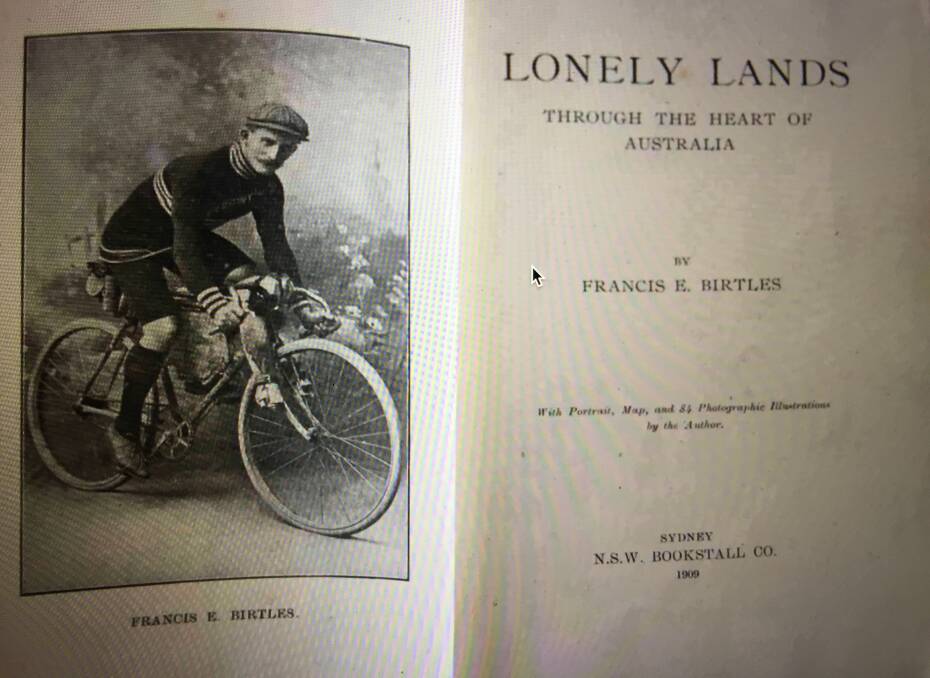
Francis Edwin Birtles (1881-1941), overlander, was born on 7 November, 1881 at Fitzroy, Victoria, son of David Birtles, bootmaker from Macclesfield. At 15 joined the merchant navy as an apprentice.
Subscribe now for unlimited access.
$0/
(min cost $0)
or signup to continue reading
Francis Birtles was our “Kingsford Smith on wheels”. Like Smithy he was one of our greatest adventurers being a bushman, cyclist, motorist, soldier, sailor, photographer, author, movie maker.
Warren Brown in his 2012 book,” Francis Birtles,” recorded that before Birtles was 19 years of age he had sailed around the world twice, fought in the Boer War.
He had been shot at and almost burned to death.
In the early nineteen hundreds, picking his way along non-existent tracks through inland Australia, he cycled around and through Australia, battling bush fires, floods, dehydration, starvation, venomous snakes and crocodiles.
When Birtles returned from South Africa he disembarked at Fremantle, Western Australia on 26 December, 1905. After a brief employment there as a lithographic artist he continued onto Sydney and then, via Brisbane, Normanton, Darwin, Alice Springs and Adelaide and back to Sydney.
His further seventy bicycle crossings of the Australian continent were lengthy and sometimes hazardous .
In the late 1928, Birtles became the first person to drive a motor car overland from London to Melbourne. On the journey he was almost strafed by RAF planes in the Middle East. He outwitted the headhunters of the Naga Hills in Burma.
On the trip he had to cut his way through jungles and hauled the car up mountain passes that seemed to be impossible to access.’’
Francis Birtles Visits Mudgee
On Saturday 14 July 1928, Francis Birtles, the intrepid traveller and overlander arrived at Mudgee at 4.30pm on Saturday afternoon in a Bean motor car.
He was met at Mudgee by R Jones, local manager of the Shell Depot, Mr Sherwood, manager of the Dunlop Rubber Company, Theo Austin of Austin’s Garage at Mudgee and local agents for the Bean Car.
On the Saturday night his Bean car was on display in Austen’s garage. He left for Bathurst early on Sunday morning.
Birtles was nearing the end of his journey having travelled overland from England through Europe and Asia, passing through Persia, India and Burma. He took the boat at Singapore and arrived at Darwin. Bathurst was the last stopping place before the final run to Sydney, then onto Melbourne.
Birtles’s tucker box found on council rubbish tip at Coolah
Rubbish tips have given up many historical finds particularly sought after old photographs, but the discovery of a personal item belonging to a notable person is a seldom occurrence.
The discovery at the Coolah Tip of Birtle’s tucker box was made by a local identity a few years back. He then traded the tucker box in to a stall holder dealer at a Bathurst Swap Meet.
There is conjecture as to how the tucker box was abandoned at Coolah. Locals will tell you a driver of the Sydney-Mudgee–Coolah mail train acquired the tucker box in Sydney.
On his last train trip from Mudgee he disposed of the tucker box to a Coolah railway fettler.
When fettler retired in 1982, at the end of train service to Coolah, he used the box for several years to store his records. He then disposed of the box to the Coolah tip, unaware of its historical value.
In 2015 Birtles’s tuckerbox was acquired by a Bathurst resident at a Swap Meet Sale. He was much aware of Birtles’ achievements, and that the box was distinctive and had a handwritten inscription on the inside of the lid reading “Francis Bertles 1922”.
Further reading: Francis Birtles, “Battle of the Ourback”, 1935; Peter Wherrett, “Grit”, 2005; Warren Brown, “Francis Birtles – Australian Adventurer”, 2012.
- by Roy Cameron, OAM

